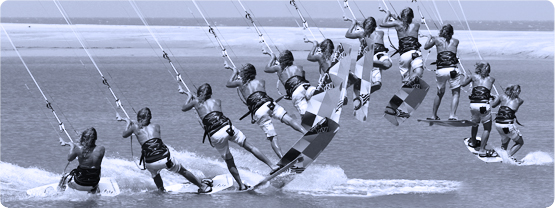Toe side front Roll To blind with Ole
We hope you are grooming well with the aid of our articles and learning every trick carefully. With ever learning day, you are going to be perfectionist in this sport. We always emphasize on doing every trick with right way and right balance, so that your every step of learning should be placed on right path. The trick which we are going to learn today has a better name, but for the moment we’ll stick to the descriptive version. Fundamentally this is a pop trick, but a subtle drifting up of the kite is more than tolerable to get you easiness to learn this trick. For those of you confident with your toe side edge this is a great trick and an inspiring step on from the toe side pop to blind which is a good prerequisite as you need both a decent pop from your toes and the blind that very same side. If this will be doing it first time, let us advise again that it will be easier to pop from your strong toe side to a new and unvisited blind rather than try and pop from your weaker toe side. Popping well from your pinkies is the key here.
The Approach
We need two things in order to pop from your toes, first speed and then a good solid edge. With the board fizzing over the water it’ll be a doddle to get it up and you’ll have momentum when you get it around. Looking at Pic A. you can see that the rider pre pop. First off the rider has his bar trimmed in close so that he can get an aggressive edge and hold the power with two hands without being pulled up onto the board. This way he can turn his head and shoulders away from the kite and stand up onto his toes, hips forward, driving the board between him and the kite. The rider has shifted his weight back on the board ready to pop, as this will help him add tension to the lines by edging harder. However if you need more speed you must keep the front knee bent and the board trimmed flat before shifting your weight back.
The assumption behind popping is much the same as from heel side – once you have enough speed, carve  up hard and stamp off the back foot. Though bearing away and then carving up from toe side is no simple task, so for the same sort of effect shifting your weight back will dig the tail in and turn the board upwind on its rocker. The trick is to be quick, shift your weight back and stamp – wait and you’ll lose your speed and nothing will happen. In Pic B. the rider has leant his weight back and simultaneously drifts the kite up slightly from 11 o’clock to give him a bit more lift whilst stamping down hard by explosively straightening his back leg. As he pops up he turns his head and shoulders down and around, initiating the front roll.
up hard and stamp off the back foot. Though bearing away and then carving up from toe side is no simple task, so for the same sort of effect shifting your weight back will dig the tail in and turn the board upwind on its rocker. The trick is to be quick, shift your weight back and stamp – wait and you’ll lose your speed and nothing will happen. In Pic B. the rider has leant his weight back and simultaneously drifts the kite up slightly from 11 o’clock to give him a bit more lift whilst stamping down hard by explosively straightening his back leg. As he pops up he turns his head and shoulders down and around, initiating the front roll.
The Rotation
The rotation will be very quick as with every front roll from toe side. This is handy, as you’ll need to spin quickly to allow for the extra twist to blind. Aim to keep two hands on the bar until you are coming around the first 360°, as this will keep you more upright and lead to a smoother landing. Looking at Pic C. as Christian reaches this point you can see that he is leading with the head. This is important; as he will know when to initiate the blind once he spots his landing. The rider here also has his knees bent and board up to help encourage a quick rotation and he keeps the bar in for that little bit of extra float. As he focuses on where he’ll land he releases his back hand, turning his head and shoulders down and around under the bar so that he can get his body around to blind whilst the board is leading. This way the board will be beneath him and ready for touchdown.
Throwing Blind
We can see in Pic D. that the rider has “thrown” the blind with the result of turning his head and shoulders down. As he drops his feet and board are leading the way. Whilst turning, he tweaks the kite down by pulling gently on his front hand. This will guarantee a bit more speed and forward momentum for the Ole, and is necessary if you sneak the kite up for takeoff.
As with all things Ole or pass you’ll need to land blind on a flat board heading at least a tiny bit downwind towards the kite. This way you’ll have no tension on the lines and so the Ole should be a walk in the park. Pic E. the rider lands upright over his flat board, having thrown the blind enough to land slightly off the wind. Try to keep your head up, as this will prevent you from breaking too much at the waist, which can in turn force weight onto your toes and put tension on the lines! If anything you want to be leaning on your heels. Landing this way the lines will be slack and therefore the bar will be close to you, not twisted around leading the way and pulling you over.
Landing upright on a flat board heading towards your kite sets you up perfectly for the grand finale, the Ole. Pic F. Standing over his board the rider can now push the bar upwind and around in front of him, so that the blind miraculously transforms back into toe side. Once the bar is across get both hands back on it, sheet in and ride off with a hefty grin on your face.
Common Problems
- If you’re not getting enough pop from toe side try sailing more across the wind before dropping your weight back and popping.
- If the kite is falling out of the sky as you land make sure that you are both popping hard into the front roll and that you give the bar a tweak forward to keep the kite from drifting too far up.
- If you slide under the kite on landing try throwing your blind more aggressively by turning your head and throwing your free hand around.
- If you’re getting pulled over & catching your heel side edge, you’re not landing enough downwind.
- If you can’t Ole and the kite pulls you over you’re edging on your toes whilst blind, so make sure your weight is on both your feet, biased towards your heels.
Keystones
Raley To Toe Side
This sport of kite boarding moves with different styles and ticks. The benefits of this sport can be measured by its refreshment and popularity worldwide. Today we all like a Raley, and funnily enough most of us learn on our preferred side, favorite foot forward, leading to a solid heel side touchdown. It looks like an embarrassment to overlook the other side and deny yourself the kudos of flicking your board both ways. Therefore the Raley to toe side, and just to prove it is a genuine move it even has its own name, the Krypt. With no trouble you can gladly learn these both hooked or unhooked. In this article, we will be going through the unhooked variant, but be assured that apart from the actual physical act of unhooking the rest remains pretty much the same for both, from approach to landing.
The Approach A.
As in every trick your approach will always determine how well things will turn out. Please have a look in the picture that the rider has her kite just below 1 o’clock, she has turned the board off the wind onto a very broad reach, whilst keeping her weight both upwind of the board and back towards the tail of the board. You can also see that her front leg is extended and both her elbows are tucked into her sides. Not only is this the perfect position from which to unhook, it is also the perfect set up for a Raley.
Now over here Kite height is very significant, too high and you’ll fly, but too low and you may not have the confidence to pop, so a happy medium is required, at a height just about where your kite is happily flying forward without creating lift, as a reference point this will be just below 1 or 11. Suddenly bearing off the wind allows you to lose tension from the lines and unhook,  and it lets the kite drop back a touch so that it will pull you downwind, easier landing, once you pop. Weight upwind positions the board between you and the kite so you can pop without the kite pulling your shoulders prematurely over the board. Then weight back over the tail so that you can rapidly and professionally carve the board upwind to pop, the extended front leg helps this. Elbows are tucked in to stop the kite from pulling your arms out straight and you over the board. Now you are all set for the Raley part.
and it lets the kite drop back a touch so that it will pull you downwind, easier landing, once you pop. Weight upwind positions the board between you and the kite so you can pop without the kite pulling your shoulders prematurely over the board. Then weight back over the tail so that you can rapidly and professionally carve the board upwind to pop, the extended front leg helps this. Elbows are tucked in to stop the kite from pulling your arms out straight and you over the board. Now you are all set for the Raley part.
The Carve Pic B.
Your action carving up against the kite needs to be accurate and quick; or else the kite will win the tug of war. With your weight back over the tail of the board you only need to turn your shoulders and the board will carve spec the shape that some lovely board designer put there for such a purpose.
Please see picture B wherein the rider has turned her shoulders and the board carves upwind, putting tension on the lines and thus generating some resistance. This resistance is your platform to pop off. Though to make sure that you are in control you need to keep your position. The easier way to do this is not to let the kite drift up, which it will want to do as you pull against it.
The rider keeps both hands in, arms bent, but her focal point is on keeping the front hand close, as it’s natural to pull on the back one as she turns away from the kite. Also as the rider carves she resists the pull from the kite with her back leg, which combined with her arms allows her to keep her weight upwind, on that edge, turning the board towards the wind.
The Pop Pic C.
Raley is simply an extreme pop. If you’ve somehow managed to oppose on the aforementioned platform you will be in a position to, and have something from which to pop.  As the board turns underneath you it’s the right time to stamp. The rider feels the board turning under her, and more significantly feels herself being pulled forwards by the kite. This is her cue to pop. She pops hard against the board with her back foot by stamping down and extending her back leg as explosively as possible. Her front leg has remained extended throughout. The amount of pop you get will depend on a few variables -speed, power, timing, aggression, but your aim is to extend, really focus on straightening your legs, uncoiling the spring which is you.
As the board turns underneath you it’s the right time to stamp. The rider feels the board turning under her, and more significantly feels herself being pulled forwards by the kite. This is her cue to pop. She pops hard against the board with her back foot by stamping down and extending her back leg as explosively as possible. Her front leg has remained extended throughout. The amount of pop you get will depend on a few variables -speed, power, timing, aggression, but your aim is to extend, really focus on straightening your legs, uncoiling the spring which is you.
The Flick Pic D.
There are two possibilities in a Raley, to end up with the board horizontal and behind you,  or flicked around vertically behind you. The second talked option will make all number of tricks more attainable and the Krypt is no exception. This flicking action is simply a continuation of the carve upwind and by extending and letting the board go you should end up here.
or flicked around vertically behind you. The second talked option will make all number of tricks more attainable and the Krypt is no exception. This flicking action is simply a continuation of the carve upwind and by extending and letting the board go you should end up here.
In this position you are airborne you also require to take stock of what is going on lest adjustments need be made. The rider has let her board flick around by carving hard to get the board into the wind and extending fully as she took off. She now wants to make ensure that she is in control, and here that means that the kite is doing what it should. If you’re well versed in Raleys, you know that once you have it nailed the kite doesn’t move, but if this side is new chances are the kite will have gone up. If it has, steer it down, the rider’s bar here is angled forward to keep the kite from rising. You’ll need to utilize both hands. The rider will also be spotting her landing, that is to say she’ll be working out where she’ll most likely land so that she can prepare for it.
Landing Gear Down Pic E.
Gravity always wins and your legs will naturally fall underneath you,  which is the beauty with a Raley. That said if you start with your kite at 45° or below Newton may not be able to save you. You can see in the picture the advantage of the flick, the rider left foot is forward as her front foot was flicked around behind her. If you have a strong toe side preference, chances are that you’ll automatically keep this position, but just to make sure, try to bring your knees up towards you as the board falls. As your knees come up you can pull your toe side leading knee under the bar, much as you would for a gentle pop to toe side. Here in picture the rider pulls her left knee through underneath her.
which is the beauty with a Raley. That said if you start with your kite at 45° or below Newton may not be able to save you. You can see in the picture the advantage of the flick, the rider left foot is forward as her front foot was flicked around behind her. If you have a strong toe side preference, chances are that you’ll automatically keep this position, but just to make sure, try to bring your knees up towards you as the board falls. As your knees come up you can pull your toe side leading knee under the bar, much as you would for a gentle pop to toe side. Here in picture the rider pulls her left knee through underneath her.
The Result Pic F.
By pulling her left knee through and under the bar, the rider will now happily and happily  land tail first for a toe side landing and a Krypt claimer. By keeping the bar in close she lands over the board and is not pulled forwards by the kite. Once you have landed, either bear away towards the kite and hook back in, or casually pop back to heel side and ponder what you’ll do next.
land tail first for a toe side landing and a Krypt claimer. By keeping the bar in close she lands over the board and is not pulled forwards by the kite. Once you have landed, either bear away towards the kite and hook back in, or casually pop back to heel side and ponder what you’ll do next.
Top Tips
- The very first tip is to start off gently, you don’t need to be hounding along at Mach 10 with the intention of a full blown Raley.
- A decent extended pop will give you the feel, so concentrate on carving and extending your legs and body before landing.
- Also have a good look on images.
Common Problems
- If you find that you are landing very downwind and having to carve around onto your heels, the chances are that either your kite has drifted up, or your error have extended which means that the kite will pull you too far downwind. Keep your arms tucked in and don’t be afraid to dive the kite down to keep you going where you should be.
- If you are catching your toe side edge on landing you don’t have enough height, so either pop harder or try with your kite slightly higher in the window. These are the things to keep In mind.
Keystones
- Approach with weight upwind, back and front leg extended
- Carve hard upwind with arms in
- Explode against the edge with your back foot
- Extend and feel the flick
- Pull arms in and bring back knee through
Toe Side Double Front Loop Downloop Transition
Your box of tricks should be always full with surplus of moves; however you have to ensure that you keep up with the transitions too. Having more ways to change direction is never a bad thing so here is another one which will have you flying out gracefully with plenty of beans. When you start doing this we will definitely recommend a controlled front loop from toe side and solid down loop. Let’s have a quick idea at a few pointers that will hopefully make the learning a tad simpler.
The Approach Pic 1.
A huge height is not required for this, however some forward momentum and plenty of float is obligatory, so you’ll need to approach this more as a double front roll with speed and the kite parked at either 1 or 11 o’clock. You’ll be taking off from your toes and therefore trim is important, hence get your sweet spot down towards you. This way you will provide a decent committed edge and still have room to send the kite without stalling it. Your toe side stance needs to be solid in this position. In the image the rider has all of his body upwind of the board; both knees are bent and driving forward with all his weight firmly on both sets of toes, creating a decent rooster tail behind him. Once he gets sweet spot close in, he can get his shoulders and head committed upwind and the kite is not pulling him up onto the board.
so you’ll need to approach this more as a double front roll with speed and the kite parked at either 1 or 11 o’clock. You’ll be taking off from your toes and therefore trim is important, hence get your sweet spot down towards you. This way you will provide a decent committed edge and still have room to send the kite without stalling it. Your toe side stance needs to be solid in this position. In the image the rider has all of his body upwind of the board; both knees are bent and driving forward with all his weight firmly on both sets of toes, creating a decent rooster tail behind him. Once he gets sweet spot close in, he can get his shoulders and head committed upwind and the kite is not pulling him up onto the board.
Getting Airborne Pic 2.
Take-off is very important in order to get enough height and time from your toes.  Get it wrong and you’ll fly down wind and pendulum under your kite! In order to initiate your front rotation you need to get your weight back so that you can kick off your back leg and in order to go up you need to send the kite with a good push and pull from both hands. The rider has sent the kite with a decent bar action, and also keeping it on the sweet spot. If he pulled it in any further the kite will pull him up onto the board and he’ll lose his edge. The order of play here is to send the kite with both knees bent and then drop your weight back ready to kick off. You will lose speed and the ability to edge hard if you drop back too early.
Get it wrong and you’ll fly down wind and pendulum under your kite! In order to initiate your front rotation you need to get your weight back so that you can kick off your back leg and in order to go up you need to send the kite with a good push and pull from both hands. The rider has sent the kite with a decent bar action, and also keeping it on the sweet spot. If he pulled it in any further the kite will pull him up onto the board and he’ll lose his edge. The order of play here is to send the kite with both knees bent and then drop your weight back ready to kick off. You will lose speed and the ability to edge hard if you drop back too early.
Roll With It Pic 3.
Starting the front roll and keeping the edge for as long as possible will help an awful lot. When the kite lifts you’ll be stamping hard off your back foot, and extending up into your rotation with as much energy as you can muster. In image you can see why it is so vital to obtain the right weight onto the back foot. The rider in image is stamping hard against the edge to initiate the double roll whilst extending up. This keeps the tail of the board in contact with the water for as long as possible giving him added whip and height. The rider throws his head and shoulders down to add inertia and already centers the bar with both hands to stop the kite flying too far back
off your back foot, and extending up into your rotation with as much energy as you can muster. In image you can see why it is so vital to obtain the right weight onto the back foot. The rider in image is stamping hard against the edge to initiate the double roll whilst extending up. This keeps the tail of the board in contact with the water for as long as possible giving him added whip and height. The rider throws his head and shoulders down to add inertia and already centers the bar with both hands to stop the kite flying too far back
Moving Forward Pic 4.
Over here in this picture you can check that the rider only past the 360 degree mark. He has finished his first rotation whilst still on the way up and now starts his second. Having kept the kite close to 12 o’clock he has both float from the kite and he can feel where the kite is. You must commit to the second rotation so as soon as you come around the first continue to turn your head and go with the energy you created on take-off.
If the kite is above you or even a little in front of you, you are in right place to well place to start the down loop. We propose two reasons to initiate it now. Initially the pull from the kite will help pull you around the rest of the way. 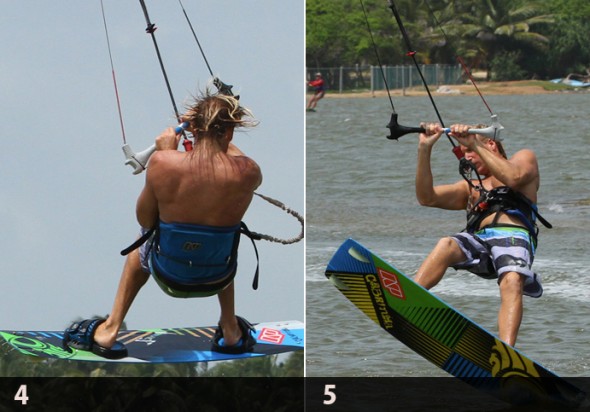 And then secondly the earlier we pull, the less aggressive, relatively speaking, we need to be on the bar. Your sits is for the kite to pull you out of the transition with speed and if the kite down loops too rapidly or from too far behind it will drop you down with no momentum.
And then secondly the earlier we pull, the less aggressive, relatively speaking, we need to be on the bar. Your sits is for the kite to pull you out of the transition with speed and if the kite down loops too rapidly or from too far behind it will drop you down with no momentum.
You can see in the images that the rider has his knees up tight, bar in close and his head is turned to rotate, all this will rooks hits turn faster. Looking at the bar you can see that he is already initiating the down loop.
Clean Landing Pic 5.
The moment of truth and another insight into the reason you must down loop early, gradually and continually. Looking at the rider in image you can see that he is landing right foot forward downwind on the tail of his board, all set to carve out of the “turn” and back onto his edge.
Realistically he isn’t finishing 2 full rotations; it is more like one and three quarters. So not only does the down loop give you speed but it pulls you out of the rotation. If you initiate the down loop later you will effectively over rotate and land on your heel side edge, stopping all momentum and you in the process. In final stage the rider keeps pulling the kite through the down loop until it is back up at 1 o’clock in the right position to ride away.
Top Tips
- To start with aim to get the rotations and a finish down loop, as this will be better than under cooking it with the kite, so when you do pull on the front hand, pull hard. This will however often result in you stopping when you land.
- Once you’ve practiced that a bit and having read the previous pointers you can see that the aim of this move is not to perform a double rotation and a down loop in the air, but rather get your rotation and use the down loop to pull you out with speed.
- Essentially you will be finishing the down loop as you land, not before. To get your head around this try some air gybe down loops If you go early and hard the kite turns, goes back up to 12 o’clock and you sink.
- Your sits is to progressively turn the kite more gently so that it will go through the bottom of the down loop before you land but as it rises it will pull you through the landing and give you a good speedy landing.
Common Problems
- If you find that you cannot edge enough when sending the kite, and therefore get pulled too much downwind whilst in the air – trim. Even if you have gorilla-length arms you need that sweet spot and the bar in close.
- If you find that you land with no power, as discussed above, you need to get the kite just in front of 12 just after take-off and then down loop the kite more slowly.
- If you’re landing on your hip and can’t get the board underneath you, this is a sign that the kite is down looping too low, so make sure you haven’t redirected the kite too much after take-off, and be a bit more aggressive when you pull on the front hand to down loop it.
Keystones
- Fast toe side with both knees driving forward.
- Rock weight back and send hard
- Kick up off back leg, head and shoulders down
- Redirect kite above you and stay small
- Start down loop progressively once you go into your 2nd rotation
Kite control is important in this trick and you have to initiate the down loop in the right moment. If you´re start down looping to early you might end up crashing hard like this guy
The correct way to do it is like this
Toe Side Pop Out to Wrapped
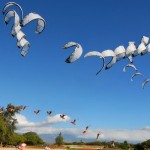
Popping from a toe side and landing in a wrapped is a great start to wrapped if you haven’t tried it before, and if you can already manage a shifty or more to wrapped, then this should be a doodle and a surefire way of adding extra style points to any move you land in toe side.
For those of you who have never tried a wrapped, it is releasing the front hand and rotating away from the bar so that you can reach around behind you and land on heel side with your arm in a self-induced arm lock. If you can go blind one way, imagine going the other way but still releasing with the same hand and turning the exact same way.
LOW AND NEAR
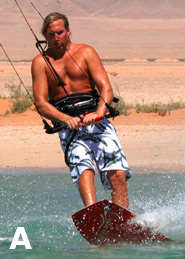 In pic A, you can see that the surfer is almost carving
In pic A, you can see that the surfer is almost carving 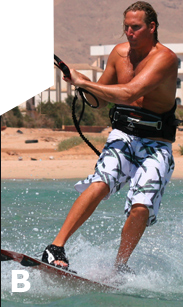 downwind away from his toe side edge. This is very sudden change of direction that does two things. First, it allows you to keep your speed for a moment even without pulling the kite, which means your board will still be planning; therefore you will be able to pop without it sticking. Second, by suddenly turning towards your kite, the lines will slacken and the bar will be light in your hands so you can keep it low and close.
downwind away from his toe side edge. This is very sudden change of direction that does two things. First, it allows you to keep your speed for a moment even without pulling the kite, which means your board will still be planning; therefore you will be able to pop without it sticking. Second, by suddenly turning towards your kite, the lines will slacken and the bar will be light in your hands so you can keep it low and close.
In pic B – Just as the surfer is about to pop, you can see that the bar is in close. With the slack in the lines the surfer can bend his arms and make sure the bar will close to him all the way around his 180 degree spin. You can also see that the kite is relatively low, say around the 45 degree mark. With the kite here it is less likely to pull the bar up and away from you. Also, ( as you’ll be releasing with your front hands) if the kite does move, it will go up, so starting with a lower tad is a good option. If you are popping off flat water, you will need to let go with your front hand as you heave up.
SPEED
As we have already mentioned, you can throw this pop whenever you come fast in your toes from another move. However, when you are trying this for the first time as a pop from toe side, your approach is pretty important because you will need speed. The simplest way to maintain speed is to unhook whilst riding heel side as you will have a better unhooked riding position. Then, you can slide the back of the board straight downwind and you are ready to pop from a very off the wind toe side. However, once you get the hang of it, you could unhook from toe side or just before you pop.
TIMING IN SEQUENCE
1 – Having approached with good speed and his kite positioned at about 10:30, the surfer has unhooked and the spun around to a very downwind toe side chasing the kite. Getting ready to pop the surfer has rocked his weight back over his trailing foot and flexed his back knee. The surfer got his bar in close to his body and is ready to spring.
2 – The surfer stamps down hard on his back foot and extends his body upwards. At the same time the surfer releases his front hand enabling him to stand over the board for a balanced spin.
3 – AS the board rises, the surfer lifts his legs and starts his rotation by turning his head and shoulders down and away from the kite.
4 – The surfer twists his wrist and turns his palm up behind his back, which helps him turn his shoulders further still. At the same time the surfer pushes his left foot through to get the board in front of him.
5 – On landing, the surfer makes sure that the bar is twisted all the way around and ready to be grabbed.
6 – The surfer reaches with this free left hand and grabs the bar.
7 – then releases his right hand.
8-9 – The surfer continues to turn his head and looks up towards the bar and gets both hands back on the bar.
10 – Sail away, hook back in and then try it from a railey to toe side.
KEYSTONES
- Speed
- Sudden chase kite
- Pop hard off back foot
- Turn head all the way
- Twist wrist and shoulders
Front Loop from Toe side
Front Loop from Toe side
The front loop from toe side is an extra bit of fun for anyone who wants themselves as proficient toe combo specialists. It is a very attainable move and can lead into a surplus of combos and tricks, both hooked and unhooked, so this is a must have for any promising crowd pleasers around you. As you start from your toes, you’ll find that the kite does a lot of work for you when it comes to spinning. As long as you get the take-off and you keep controlling the kite’s atmosphere, it will be a well aligned move.
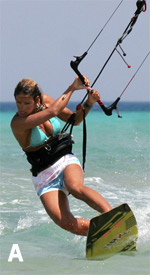 Pic A – The surfer is edging against the kite. Not wanting to draw too much attention to it, but this is another classic kite face trick. If you thought edging upwind requires some effort, now you will edge upwind and try to keep your weight low against the lift of the kite, you will need to use all your steel on it.
Pic A – The surfer is edging against the kite. Not wanting to draw too much attention to it, but this is another classic kite face trick. If you thought edging upwind requires some effort, now you will edge upwind and try to keep your weight low against the lift of the kite, you will need to use all your steel on it.
For starters, trim your bar down towards you. With the bar nearer your body, you will be able to edge well with both hands on the bar, thus being able to send the kite and keep the control on it. Even though the surfer’s bar is angled back to send the kite, the front arm is still bent slightly, so the kite doesn’t pull the surfer around. You can see how the surfer has his neck twisted and face really looking over his shoulder and down. This allows the surfer to commit against the kite and keep the body weight low and forward, whilst still keeping both hands on the bar. This way the surfer is able to hold the edge for that a little bit longer. Just like with a heel side jump move. If the surfer has a cheeky peek at the kite, it will come off the edge.
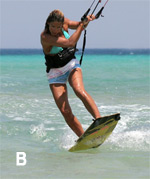 Pic B – Demonstrated the take-off perfectly. The surfer has popped up off the water after the feeling of the rising kite has been felt. Even though you use the kite for this trick, you need to “go early” because you’ll not be able to resist the same way that you do on your heels. Even though the surfer is extending up, keep the head down and twisted around plus continue to commit the weight upwind against the pull of the kite. It is tempting to drift the kite up slowly, but if you are fairly aggressive, you have more chance of holding your edge until the right time. This is your only chance to give yourself enough height to complete the move.
Pic B – Demonstrated the take-off perfectly. The surfer has popped up off the water after the feeling of the rising kite has been felt. Even though you use the kite for this trick, you need to “go early” because you’ll not be able to resist the same way that you do on your heels. Even though the surfer is extending up, keep the head down and twisted around plus continue to commit the weight upwind against the pull of the kite. It is tempting to drift the kite up slowly, but if you are fairly aggressive, you have more chance of holding your edge until the right time. This is your only chance to give yourself enough height to complete the move.
Also, as the surfer starts to take-off, the bar levels have been off already. This is due to popping up early. As the surfer essentially loses the edge as the pop goes, the kite will fly further back as the surfer pendulum underneath it. Once again this is only possible because the surfer has the bar trimmed in near.
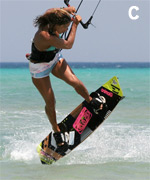 Pic C – The final part of the surfer’s take-off is the initiation of his forward rotation. Just as with a heel side front loop, much of the momentum comes from the back leg kicking off the water, and as the surfer popped off, his back leg will help in that phase. If you look at the surfer’s head, it is no longer looking upwind over his shoulder. By turning his head to look forward and downwind, his body will automatically start to uncoil, and this is a further help by the kite pulling in the harness hook.
Pic C – The final part of the surfer’s take-off is the initiation of his forward rotation. Just as with a heel side front loop, much of the momentum comes from the back leg kicking off the water, and as the surfer popped off, his back leg will help in that phase. If you look at the surfer’s head, it is no longer looking upwind over his shoulder. By turning his head to look forward and downwind, his body will automatically start to uncoil, and this is a further help by the kite pulling in the harness hook.
From here onwards it is all about keeping the bar in and keeping the kite forward while getting your body tucked up and small, so that you can look over your back shoulder and complete the rotation.
Sequences
1-2. With his kite at 1 o’clock and riding with good speed on his toe, the surfer edges hard and sends his kite back for a jump whilst trying to look upwind.
3. As the kite starts to lift up, the surfer explodes up off his back leg whilst committing his weight upwind and of the board.
4. As the surfer kicks off, turns his head and looks downwind under the bar. At this point the surfer is already redirecting the kite forward with his front hand.
5. This impulse coupled with the pulling of the kite, the harness throws the surfer into a front rotation. You can see how the surfer is pulling hard on his front hand.
6. This looks familiar. The surfer is now facing upwind and it looks exactly like a normal front loop. The surfer has the bar pulled in to keep the tension on the lines, the surfer is looking over his back (left) shoulder to continue rotating combing with his knees pulled up to increase the speed of the rotation.
7-8. The surfer keeps looking over his shoulder in an effort to see the water and where to land.
9. As the surfer completes his rotation. The surfer dives the kite hard with his front hand and focuses on his landing.
10. The diving kite pulls the surfer off downwind and stops his rotation. Now the surfer can drop his feet and is ready for the landing stage.
11. The surfer lands tail first with his board pointing downwind for a clean landing. From here the surfer can gather his thoughts before carving back onto his edge and not spinning his bar.
Keystones
1. Trim your kite to get the bar close
2. Edge hard by turning your head upwind
3. Send the kite (do not drift it.)
4. Pop early and turn your head the opposite way
5. Redirect with meaning
And the video:




